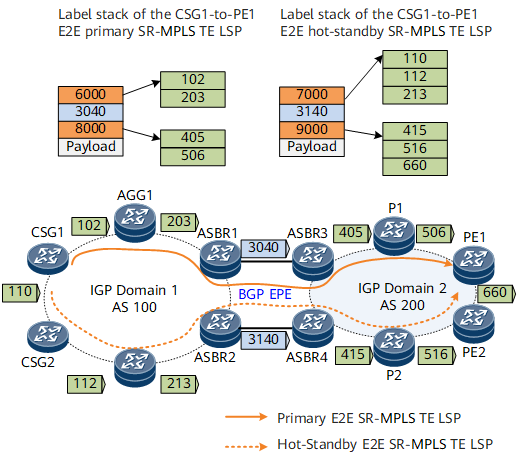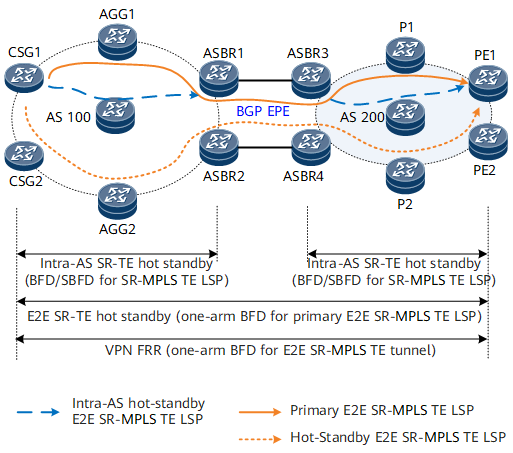Reliability of E2E SR-MPLS TE Tunnels
E2E SR-MPLS TE Hot-Standby
Hot standby (HSB) is supported by E2E SR-MPLS TE tunnels. With HSB enabled, a device creates an HSB LSP once creating a primary LSP. The HSB LSP remains in the hot standby state. The HSB LSP protects an entire LSP and provides an E2E traffic protection measure.
In Figure 1, HSB is configured on the ingress CGS1. After CSG1 creates the primary LSP, it immediately creates an HSB LSP. An SR-MPLS TE tunnel contains two LSPs. If the ingress detects a primary LSP fault, the ingress switches traffic to the HSB LSP. After the primary LSP recovers, the ingress switches traffic back to the primary LSP. During the process, the SR-MPLS TE tunnel remains Up.
In Figure 1, the controller calculates a path CSG1->AGG1->ASBR1->ASBR3->P1->PE1 for the primary LSP of an E2E SR-MPLS TE tunnel. The path is mapped to a label stack {6000, 3040, 8000}, where 6000 and 8000 are binding SID labels, and 3040 is a BGP peer SID. The HSB LSP of the E2E SR-MPLS TE tunnel is established over the path CSG1->CSG2->AGG2->ASBR2->ASBR4->P2->PE2->PE1. This path is mapped to a label stack {7000, 3140, 9000}, where 7000 and 9000 are binding SID labels, and 3140 is a BGP peer SID.
E2E SR-MPLS TE Tunnel Protection
- Within an AS domain: If an E2E SR-MPLS TE LSP is faulty in an AS domain, a protection function of an intra-AS SR-MPLS TE tunnel is preferred. For example, intra-AS SR-MPLS TE hot standby and SR-MPLS TE FRR is used. For details, see Reliability of E2E SR-MPLS TE Tunnels.
- E2E LSP level: Within an E2E SR-MPLS TE tunnel, an HSB LSP protects the primary LSP to ensure that the E2E SR-MPLS TE tunnel status remains Up. The primary LSP is monitored using one-arm BFD for E2E SR-MPLS TE LSP that can rapidly detect faults.
- E2E tunnel level protection: If both the primary and HSB LSPs in an E2E SR-MPLS TE tunnel fail, one-arm BFD for E2E SR-MPLS TE tunnel quickly detects the faults and instructs the system to set the E2E SR-MPLS TE tunnel to Down. In this case, upper-layer applications, for example, VPN, can be switched to another E2E SR-MPLS TE tunnel using VPN FRR.

